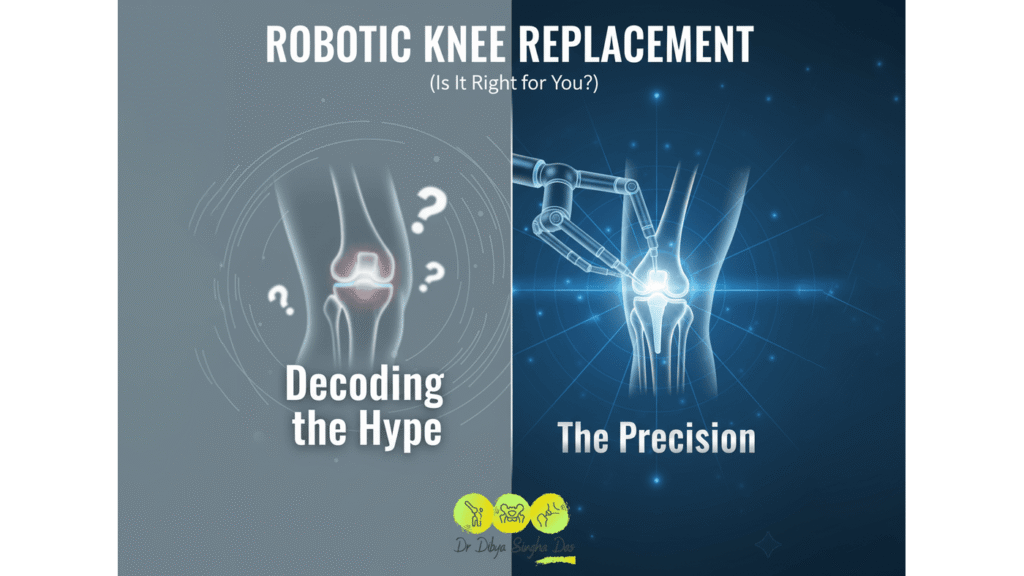For decades, knee replacement surgery has been a life-changing procedure, offering freedom from chronic arthritis pain. Today, we are witnessing a revolution in this field: Robotic-Assisted Knee Replacement Surgery.
As a surgeon who has performed over 5000 knee replacements, I have embraced robotic technology not as a gimmick, but as a tool for achieving unparalleled precision. However, patients often ask: Is a robotic procedure truly better? And is it the right choice for my knee?
Here is a breakdown of the precision behind the “hype,” and what it means for your recovery.
What Does “Robotic” Actually Mean?
The term “Robotic Surgery” is often misunderstood. It does not mean a robot is operating on you. It means a highly skilled orthopedic surgeon, like myself, is utilizing an advanced robotic arm or navigation system to execute the plan with extreme accuracy.
It is technology guiding the surgeon’s hand, not replacing it.
The Precision Advantage
The core benefit of robotic assistance lies in pre-operative planning and intra-operative precision:
3D Personalized Planning: Before the surgery even begins, a CT scan or specialized X-rays of your knee create a detailed 3D map. This allows me to virtually plan the exact placement and size of the implant, customized down to the millimeter for your unique anatomy.
Implant Alignment: The robotic system provides real-time data and guidance, ensuring the bone cuts required to fit the implant are performed within the pre-determined, precise boundaries. This ultra-accurate alignment minimizes errors that can affect your long-term knee function and lifespan of the implant.
Soft-Tissue Balancing: The robot helps assess and balance the surrounding ligaments and soft tissues during the procedure. A perfectly balanced knee is crucial for a natural feel and full range of motion after recovery.
Robotic Surgery vs. Traditional Knee Replacement
| Feature | Traditional Knee Replacement | Robotic Knee Replacement |
| Planning | Based on 2D X-rays and intra-operative visual estimation. | Based on 3D personalized models, allowing for precise pre-planning. |
| Accuracy | Excellent, but dependent on manual alignment tools and surgeon skill. | Superior, using a haptic feedback system to prevent the surgeon from deviating from the precise plan. |
| Long-Term Goal | Good pain relief and functional restoration. | High potential for a more “natural-feeling” knee and longer implant survival due to optimal alignment. |
| Incision | Standard size. | Often allows for smaller, less invasive incisions. |
Is Robotic Knee Replacement Right for You?
While robotic surgery offers significant advantages, it is a technique best utilized by surgeons with specialized experience.
You are an excellent candidate if you suffer from:
Severe Osteoarthritis: Where cartilage loss is significant and causing chronic, debilitating pain.
Failed Conservative Treatments: You’ve tried injections, medication, and physical therapy without lasting relief.
Need for Maximum Precision: Patients often choose robotic surgery when seeking the best possible long-term outcomes, especially active individuals who want a return to full function.
Our Commitment to You:
At Utkal Hospital and Orthoone Orthopedics Clinic, we combine my experience of thousands of successful joint surgeries with cutting-edge robotic technology. My goal is to use the best available tools to deliver a personalized surgery that gets you back on your feet—and back to life—faster and stronger.
If chronic knee pain is holding you back, it’s time to explore the precision of robotic surgery.
Book a consultation with Dr. Dibya Singha to discuss your personalized treatment plan.

